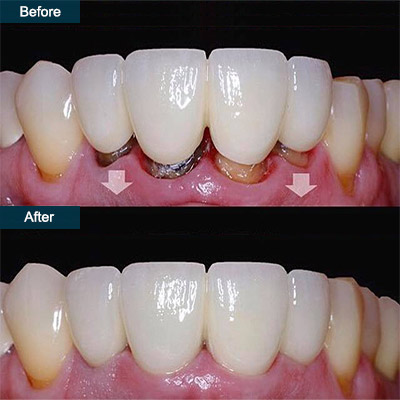
Diagnosis: After a careful oral examination and study of my dental condition, my dentist has advised me that I have significant gum recession and/or gum defects.
Recommended Treatment: In order to treat this condition, my dentist has recommended surgical gingival augmentation procedures (gum/tissue grafts) be performed in areas of my mouth with significant gum recession. I understand that a local anesthetic will be administered. I understand that this surgical procedure involves the transplanting of a thin strip of gum from human donor tissue (Alloderm). The transplanted strip of gum can be placed at the base of the remaining gum or it can be placed to partially cover the root surface exposed by the recession. A periodontal dressing or bandage may be placed.
Alloderm Grafts: Alloderm grafts are processed from human donor skin acquired from tissue banks that adhere to FDA requirements with screening of human donor tissue to the standards of the American Association of Tissue Banks. Extensive medical histories and blood samples of each donor are screened for bacteria and viruses, including HIV. The alloderm process also includes a step that incubates grafts with a viral inactivation agent to provide some assurance that agents including viral contaminants are not present following processing, although this cannot guarantee that the tissue is absolutely virus-free.
Expected Benefits: The purpose of the gingival augmentation surgery is to create an amount of attached gum tissue adequate to reduce the likelihood of further gum recession and protect the underlying bone from trauma. Another purpose of this procedure may be to cover exposed root surfaces, to enhance the appearance of the teeth and gumline or to prevent or treat root sensitivity or root decay.
Principal Risks and Complications: I understand that a small number of patients do not respond successfully to gingival augmentation surgery. If a transplant is placed as to partially cover the root surface exposed by recession the gum placed over the root may shrink back during healing. In such case, the attempt to cover the exposed root may not be completely successful. Indeed, in some cases it may result in more recession with increased spacing between the teeth. I understand complications may result from gingival augmentation procedures, drugs and anesthetics. These complications include, but are not limited to, post-surgical infection, bleeding, swelling and pain, tooth resorption, facial discoloration, a transient but occasional permanent numbness of the lower lip, tongue, teeth, chin or gum, jaw joint injury or associated muscle spasm, transient but occasional permanent increased tooth looseness, tooth sensitivity to hot, cold, sweet and acidic foods, cracking, stretching or bruising of the mouth, restricted ability to open the mouth for several days or weeks, impact on speech, allergic reactions, injury to adjacent teeth, delayed healing and accidental swallowing of foreign matter. The exact duration of any complications cannot be determined and they may be irreversible. There is no method that will accurately predict or evaluate how my gum will heal. I understand that there may be a need for a second procedure if the initial results are not satisfactory. Additionally, the success of gingival augmentation can be affected by medical conditions, dietary and nutritional problems, smoking, alcohol consumption, inadequate oral hygiene, clenching and grinding the teeth, infection inside the nerve of the tooth, tooth fracture and medications that I have been taking. To my knowledge, I have reported to my dentist any prior drug reactions, allergies, diseases, symptoms, habits or conditions that might, in any way, relate to this surgical procedure. For patients who are taking or have taken medications (pills or injectable/intravenous) for cancer or osteoporosis such as bisphosphonates (Prolia,Fosamax, Didromel, Boniva, Aredia, Actonel, Skelid, Reclast and Zometa, etc.) there is an increased risk for osteonecrosis or loss of bone or part of the jaw due to non-living bone tissue. Treatment for osteoporosis can potentially be very easy to manage or very difficult and painful. In very rare cases it may be necessary to leave a small piece of tissue if the surgical procedure to retrieve it is too extensive. The exact duration of any complications cannot be determined and they may be irreversible.
Alternatives to Suggested Treatment: I understand that alternatives to gingival augmentation are 1) no treatment 2) continued monitoring for progressive recession and 3) modification of technique for brushing my teeth. I understand that with this condition, further recession of the gum and underlying bone loss may occur without treatment.
Necessary Follow-up Care and Self-Care: I will need to come to my appointments following my surgery so that my healing may be monitored and so that my dentist can evaluate and report on the outcome of surgery upon completion of healing. Maintenance also may include adjustment of prosthetic appliances. I understand that my personal daily care recommended by my dentist and taking all prescribed medications are important to the ultimate success of the procedure. I have received written pre-surgical and post-operative care instructions.
No Warranty or Guarantee: I hereby acknowledge that no guarantee, warranty or assurance has been given to me that the proposed treatment will be successful. There exist the risks of failure, relapse, additional treatment, or even worsening of my present condition, including the possible loss of certain teeth, despite the best of care.
Publication of Records: I authorize photos, slides, x-rays or any other viewings of my care and treatment during or after its completion to be used for the advancement of dentistry. My identity will not be revealed to the general public without my permission.
If you should have any questions or concerns, please call us at anytime